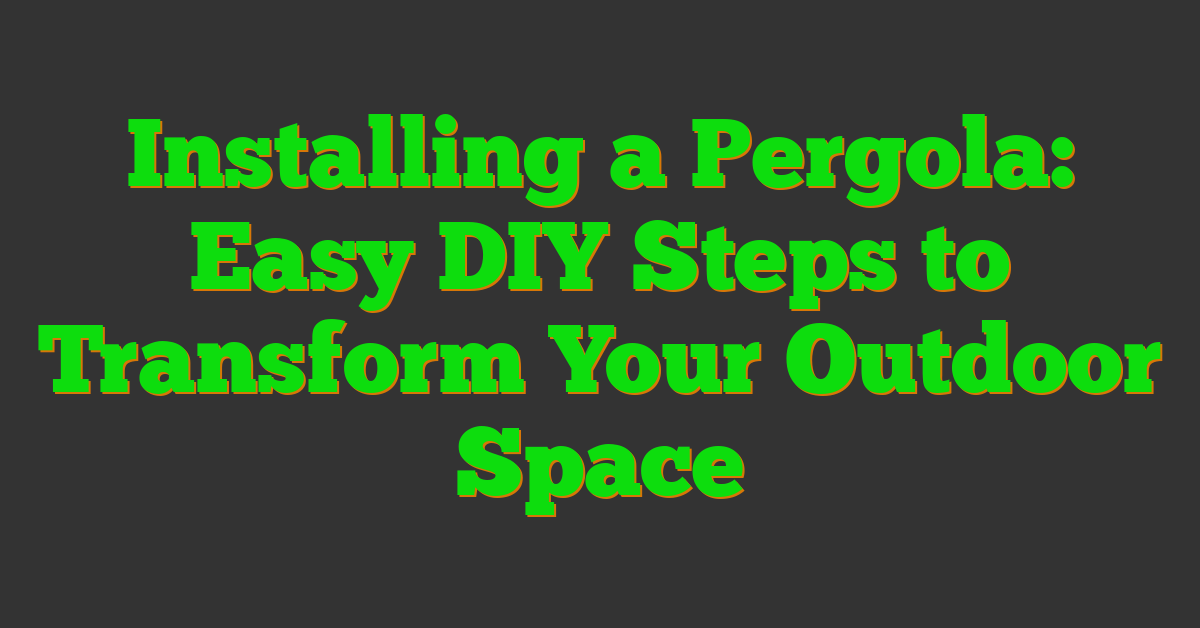Transforming your outdoor space into a cozy retreat can be simpler than you think. I’ve always loved the charm a pergola adds, and installing one myself was an incredibly rewarding project. With a bit of planning and the right tools a pergola can completely change the look and feel of your backyard.

In this guide I’ll walk you through the DIY steps to install a pergola from start to finish. Whether you’re a seasoned DIY enthusiast or just getting started I’m here to make the process easy and enjoyable. Let’s dive in and create a beautiful outdoor haven together.
Planning and Preparation
Planning lays the foundation for a successful pergola installation. I focus on key factors to ensure everything aligns perfectly.
Selecting the Right Location
I assess sunlight exposure to determine the best spot for shade and comfort. Measuring the intended area, I ensure there’s at least 10 feet of clearance from structures. I check the ground for levelness, making adjustments to avoid future stability issues. Proximity to my house provides easy access to power sources if needed.
Obtaining Permits
I research local building codes to understand permit requirements. Visiting my city’s website, I find the necessary forms and submit them online. Scheduling inspections ensures my pergola meets all safety standards. Keeping records of approvals helps streamline the installation process.
Tools and Materials Needed
To install a pergola successfully, gather the following tools and materials:
Tools
- Measuring Tape: Ensures accurate dimensions for your pergola.
- Level: Guarantees that all posts and beams are perfectly horizontal and vertical.
- Power Drill: Facilitates the assembly of pergola components with ease.
- Circular Saw: Cuts lumber to the required lengths efficiently.
- Post Hole Digger: Creates precise holes for setting the pergola posts.
- Ladder: Provides access to higher sections during installation.
- Safety Gear: Includes gloves and goggles to protect during construction.
Materials
- Pressure-Treated Lumber: Durable and resistant to outdoor elements, ideal for pergola frames.
- Concrete Mix: Secures the posts firmly in the ground for stability.
- Galvanized Screws: Prevents rust and ensures long-lasting connections.
- Brackets and Fasteners: Supports the structural integrity of the pergola.
- Finishing Stain or Paint: Protects the wood and enhances the pergola’s appearance.
- Decorative Elements: Adds personal style, such as climbing plants or lighting fixtures.
Having these tools and materials on hand prepares you for each step of the pergola installation, making the DIY process smoother and more efficient.
Step-by-Step Installation
Installing a pergola involves careful planning and precise execution. I’ll guide you through each stage to ensure a successful DIY project.
Building the Foundation
- Mark the Layout: I use stakes and string to outline the pergola’s perimeter, ensuring accurate measurements.
- Dig Post Holes: I utilize a post hole digger to create holes at least 2 feet deep, providing stability.
- Set the Posts: I position the pressure-treated lumber into the holes, align them vertically with a level, then secure them with concrete mix.
- Allow to Cure: I let the concrete set for 24 hours to ensure a solid foundation before proceeding.
Assembling the Frame
- Connect the Beams: I attach the horizontal beams to the vertical posts using galvanized screws and brackets, ensuring each connection is secure.
- Install Rafters: I space rafters 2 feet apart along the beams, fastening them firmly with screws.
- Add Cross Beams: I place cross beams perpendicular to the rafters for additional support, maintaining consistent spacing.
- Secure the Structure: I double-check all connections for stability, making adjustments as necessary to maintain alignment.
Tips and Best Practices
Choose durable materials to ensure your pergola withstands weather changes. I use pressure-treated lumber for longevity and resistance to rot.
Measure accurately before cutting any pieces. Precise measurements prevent waste and ensure a snug fit during assembly.
Level each post to maintain structural stability. I double-check with a spirit level to avoid unevenness that could compromise the pergola.
Secure posts firmly with concrete for maximum support. Pouring concrete accurately around each post guarantees a solid foundation.
Use galvanized screws to resist rust and extend the life of your pergola. I always select high-quality fasteners to maintain integrity over time.
Protect the wood with a quality stain or paint. Applying a finish not only enhances appearance but also guards against moisture and UV damage.
Plan for proper ventilation by spacing rafters adequately. This allows air circulation, reducing heat buildup and preventing mold growth.
Incorporate lighting for functionality and ambiance. I install outdoor-rated fixtures to create a welcoming atmosphere during evening hours.
Regularly inspect your pergola for any signs of wear or damage. Routine maintenance keeps your structure safe and looking great.
Follow local building codes to ensure compliance and safety. I always consult with local authorities before starting to avoid any legal issues.
Conclusion
Building a pergola has been one of my favorite projects. Seeing the transformation of my outdoor space into a cozy retreat was incredibly rewarding.
« Step-by-Step Guide to Making a Birdhouse for Your Garden Build Your Own Patio: Step-by-Step DIY Guide for a Beautiful Outdoor Space »
If you’re up for a DIY adventure, installing a pergola is totally achievable. With the right planning and tools, you can create a beautiful structure that enhances your backyard.
Enjoy the shade, the fresh air, and the new space to relax or entertain. Here’s to many wonderful moments under your new pergola!
















